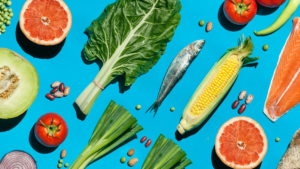I can’t believe people want to be vegan. The response to books like Skinny Bitch and Thug Kitchen, while inspiring, continues to shock me. The commitment requires so much vigilance. The quest for a nutrition-rich vegan diet is even more challenging. For those of you less die-hard, we present the flexitarian diet.
A flexitarian is just what it sounds like a vegan or vegetarian with a flexible approach to what can be included in the plan. Flexitarian diets offer many advantages because the hyper-vigilant element is removed. You can eat what makes sense to you while following the values that are right for you. Flexitarians also have the benefit of more nutritional options and less dependency on protein powders and other semi-processed sources of food.
What Kind of Flexitarian Are You?

Here we’ll discuss your options as well as the nutritional elements that come with them. You’ll also get advice on how to make informed label choices in your flexitarian adventure.
Flexitarian Vegetarian: Flexitarians are semi–vegetarians. They do not eat animal products most of the time, but will occasionally eat fish or meat.
Pescetarian

Vegetarians who don’t eat animal meat or poultry but do eat fish, dairy, and eggs often fall under the pescetarian umbrella. Although pescetarian refers only to fish, the word allows this type of flexitarian to summarize their diet easily in one word.
Pescetarians have a big nutritional advantage. Fish provide an abundance of nutrients that are lacking in almost every major diet. Fat-soluble vitamin D and omega-3 fatty acids give pescetarians natural protection from heart disease, stroke, and inflammatory health conditions. Studies have also shown that a pescetarian diet can increase grey matter in the brain and slow cognitive impairment. Fish is also high in vitamin B-12, which is all but absent in a completely plant-based diet.
Food Labels for the Pescetarian Diet
Always chose wild-caught fish over farmed fish. Be aware, however, that wild-caught fish may still contain traces of mercury (a naturally occurring metal that can be dangerous for pregnant women).
Don’t be fooled by “organic”. Unlike vegetable labeling, when it comes to fish, organic labels are not regulated and mean nothing. If you stick to “wild caught” you’ll be getting the most organic, range-free equivalent possible in the animal world.
Eggs

Did you know that eggs contain almost every nutrient and mineral necessary for the function of the human body? In some cases, on traces of each nutrient exist, but this fact alone makes eggs miniature nutrient bombs. Consider eggs the real-food version of a multi-vitamin. If you don’t eat animal products, but you are flexitarian enough to eat eggs—usually for their intense nutritional component, you can call yourself Ovo vegetarian. Or call yourself nothing at all, if labels aren’t your thing.
Egg Labels
You can find yourself quickly overwhelmed by the variety of labels on egg cartons. The best to go for are hormone-free, antibiotic-free, cage-free, and certified humane. You’re going to pay significantly more for such pure eggs, but considering the health benefits, it’s worth it.
Dairy
While a focus on non-fat dairy used to take precedence, new studies are showing that grass-fed, full-fat dairy can reduce your risk of heart disease. In fact, an Australian study found that people who consumed the greatest amount of full-fat dairy had a 69% lower risk of dying from heart disease than the group who consumed none at all.
Dairy Labels
Aim for antibiotic and hormone-free dairy products from grass-fed cows. This includes milk, butter, and cheese. Don’t worry so much about the fat. Turns out, it just might be good for.
Your Flexitarian Diet

Regardless of which flexitarian diet you choose, or why you chose it, doesn’t change the fact that your diet still has to meet your macro & micro nutrient needs. Macronutrients are the big building blocks of nutrition: proteins, carbohydrates, and fats. Micronutrients are the essential vitamins, minerals, and amino acids. You can determine your nutritional needs and you use those as guidelines to establish a vegetarian meal plan.
Each person who chooses a flexitarian diet will determine what their diet looks like for them based on their dietary preferences and the foods available to them. For instance, flexitarians may have specific guidelines for how they eat at home but may be more flexible when they dine out or attend events or parties. There are no right or wrong ways to be a flexitarian. You have to make the best decisions for you based on your needs and lifestyle.
Eating a varied diet that includes different proteins, carbohydrates, and fats will help you meet all of your macro and micronutrient needs. Basing your flexitarian diet on your nutritional needs combined with your personal lifestyle goals will ensure that you eat right for you. When you first establish which type of flexitarian diet you will eat, understand that it may take a while to learn how it works and how it will work for you. Be patient with yourself and have fun trying new food

